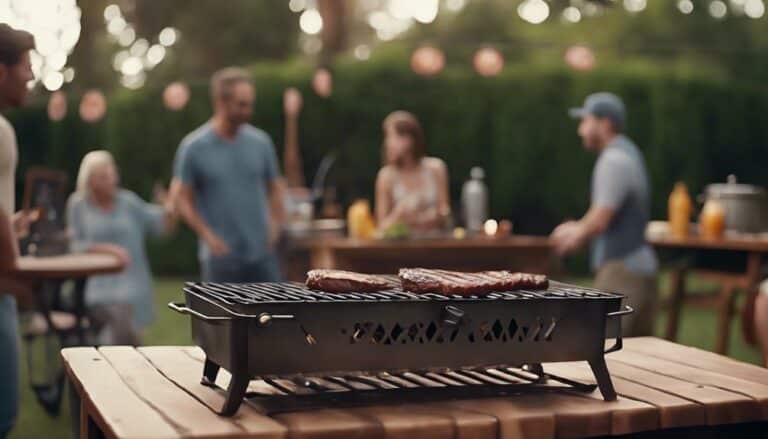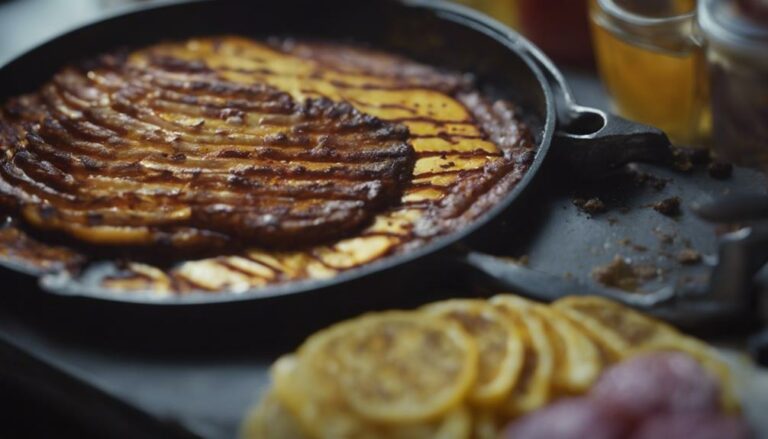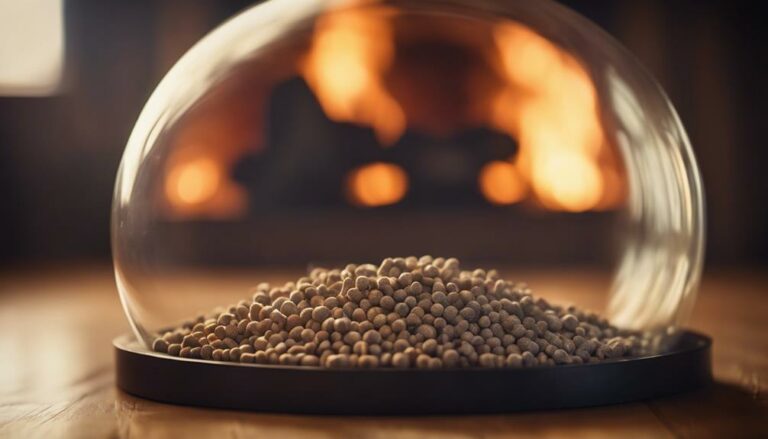As an avid BBQ fan, I know there’s nothing quite like the flavor of low and slow cooked meats. You can really bring out the best in your BBQ when you master the techniques of low and slow cooking.
In this article, I’ll share my knowledge and experience on how to prepare your grill, select the best fuel options, and enhance your BBQ with tips and tricks.
Let’s get started on mastering the flavor of low and slow BBQ cooking!
Table of Contents
Key Takeaways
- Slow cooking method enhances the natural flavor of the meat and allows for even cooking throughout.
- Prepping the grill is essential for successful low and slow cooking, including scrubbing the grill, seasoning it, and bringing it up to temperature.
- Charcoal offers a unique flavor that is difficult to achieve with other fuels, and different wood chips can be used for added smoke flavor.
- Low and slow cooking brings out intense flavors, results in tender texture, and allows for the infusion of flavor through marinades, rubs, and sauces.
Understanding the Basics of Low and Slow Cooking
Learning the basics of low and slow cooking is essential for mastering the flavors of BBQ. With proper heat control and smoke flavor, you can create delicious dishes that are sure to impress.
For starters, a slow and low cooking method allows the food to be cooked slowly over low heat for a long period of time. This results in tender, juicy meats that have been cooked evenly throughout. It also helps to bring out the natural flavor of the meat and enhances the smoke flavor.
Furthermore, the slow cooking process allows the flavors of the spices and rubs to be absorbed more thoroughly into the meat. This results in a more intense and flavorful meal.
Finally, the low and slow cooking method is an excellent way to create dishes with a complex balance of flavors. These flavors will linger on your palate and leave you wanting more.
Mastering the low and slow cooking technique is the key to unlocking the flavors of BBQ.

Preparing Your Grill for Low and Slow Cooking
Before I get started with low and slow cookin’, I gotta make sure my grill is prepped. That means optimizing temperature, ensuring it’s hot enough to slow cook, but not too hot to burn. Seasoning methods are key too. I’ll give the inside of the grill a thorough scrub with a wire brush and then rub it down with oil. This will help create a great sear and a smoky flavor. The table below outlines my prepping process:
| Prepping Step | Time | Description |
|---|---|---|
| Scrub | 5 mins | Scrub the inside of the grill with a wire brush. |
| Oil | 5 mins | Rub the grill down with oil. |
| Heat | 10 mins | Bring the grill up to temperature for slow cooking. |
I’m ready to go! Low and slow cookin’ is all about patience and adding flavor. Now that my grill is prepped, I’m ready to start masterin’ some serious BBQ flavor.
BBQ Fuel Options for Low and Slow Cooking
When it comes to low and slow cooking, there are a few fuel options to consider.
Charcoal is the classic option, but wood is also an option for adding flavor to your BBQ.
Both have their pros and cons, so it’s important to understand the differences to make the best choice for your BBQ.
Charcoal Use
Charcoal is a critical component for perfecting low and slow cooking techniques when mastering BBQ flavor. Charcoal grilling offers a unique flavor that’s difficult to achieve with other fuel sources. Here are a few important factors to consider when using charcoal to master BBQ flavor:
Charcoal Selection
- Choose lump charcoal for a fast, hot burn.
- Briquettes offer longer burn times and even heat.
- Use a combination of both for more control.
Charcoal Grilling
- Use a chimney starter for faster and easier lighting.
- Keep a water spray bottle nearby to control flare-ups.
- Experiment with different wood chips to add smoke flavor.
Charcoal Maintenance
- Monitor the coal bed temperature to achieve desired results.
- Always dispose of cooled coals in a safe, non-flammable container.
- Use a grill brush to keep grates clean and help prevent sticking.
Mastering BBQ flavor with charcoal requires practice, but the results are well worth it!
Wood Types
Experimenting with different wood chips can add a unique flavor to my grilled dishes. Smoking chips are an integral part of the low and slow BBQ process, as they provide the perfect combination of heat control and flavor enhancement. Wood chips come in a variety of flavors, from mild hickory to robust mesquite, and everything in between. Each type of wood imparts a different flavor to the dish, so it’s important to choose the right type of wood chips for the meal. For example, hickory is often used for pork, while apple is great for poultry.
It’s also important to remember that different woods burn at different temperatures, so be sure to select a wood chip that will burn for the appropriate time. For instance, if I’m making a brisket, I’ll want to use a wood chip that will burn for the full 10-12 hours of cooking. With a little experimentation, I can find the right wood for the job and add a unique flavor to my dishes.

The Benefits of Low and Slow Cooking
Low and slow cooking is the key to unlocking amazing flavors and textures in your BBQ. By taking the time to cook your food slowly, you can bring out intense flavors and create a tender, juicy texture that can’t be achieved through any other cooking method.
It’s a great way to impress your guests and take your BBQ to the next level.
Intense Flavor
I’m all about adding intense flavor to my BBQ dishes and getting creative with my seasonings.
When it comes to low and slow cooking techniques, there are three main ways to achieve intense flavor:
Smokey aromas
- Smoking wood chips
- Smoking the dish
- Utilizing a smoker
Flavor infusion
- Marinades
- Rubs
- Sauces
Spice combinations
- Sweet and savory
- Tangy and spicy
- Herbs and aromatics
With the right techniques, low and slow cooking can bring out the most intense and delicious flavors. The trick is to experiment with different spice combinations and techniques to find the perfect flavor that will make your BBQ dishes stand out.
Tender Texture
To get the most tender texture for my BBQ dishes, I’m all about mastering the art of low and slow cooking. Barbecuing time is key; for the best results, I keep the heat low and the cooking slow, adjusting the intensity of the heat depending on the food I’m preparing. This helps to ensure that each dish has the desired tenderness level.
I often use a combination of different techniques, such as smoking, braising, and roasting, to bring out the best flavor and texture. I also make sure to pay attention to the marinade or rub that I use, as this can add extra flavor and help tenderize the meat.
Low and slow cooking is a great way to bring out the full flavor of any barbecue dish.
Tips and Tricks for Low and Slow Cooking
Mastering the art of low and slow cooking requires some tips and tricks:
Moisture Control
- Use a water pan to add moisture to the cooking chamber.
- Maintain the lid of the grill or smoker during the cooking process.
- Add wood chips to the fire to create a smokier flavor.
Temperature Regulation
- Find a balance between direct and indirect heat.
- Use a thermometer to track the temperature of the cooking chamber.
- Maintain the temperature in the cooking chamber throughout the process.
Food Preparation
- Prepare the food in advance to save time.
- Use rubs and marinades to add flavor to the food.
- Trim fat from the meat to ensure even cooking.
Low and slow cooking is an art form, and with the right tips and tricks, you can master it to create delicious, flavorful meals.
Flavoring Your BBQ With Low and Slow Cooking
With low and slow cooking, I’m able to add layers of flavor to my BBQ. From smoke infused flavor to seasoning rubs, the possibilities are endless.
It all begins with heat. I use a charcoal or wood fire to create a slow and steady heat. To add a smoky flavor, I add wood chips, chunks, or logs to the fire.
Another way to add flavor is with a seasoning rub. I coat my meat with a mix of spices and herbs. I then let the meat slowly cook, allowing the flavors to blend and intensify over time.
This low and slow technique locks in the moisture and creates a delicious, perfectly cooked meal. With a few simple tips and tricks, I can create a BBQ feast everyone will love.
Troubleshooting Low and Slow Cooking Issues
Troubleshooting low and slow cooking can be tricky, but I’m up for the challenge! Here’s what to look out for when mastering the art of BBQ flavor:
Pre-Heating Techniques
- Use a thermometer to ensure your grill is pre-heated to the correct temperature
- Heat evenly to avoid hot spots that can burn food
- Start with a clean grill surface
Temperature Control
- Monitor the temperature to ensure it remains consistent throughout the cooking process
- Adjust the vents to control the temperature
- Use wood chips for a smoky flavor
Smoking Times
- Know the general smoking times for the type of food to be cooked
- Use a meat thermometer to check for doneness
- Let the food rest before serving to allow flavors to fully develop.
Frequently Asked Questions
What Type of Food Can I Cook Using Low and Slow Cooking Techniques?
Using low and slow cooking techniques, I can create delicious dishes like venison stew and pulled pork. I’m passionate about the unique flavor of slow-cooked meals and the way they bring out the best in my ingredients.
What Is the Difference Between Low and Slow Cooking and Traditional Grilling?
Low and slow cooking requires understanding heat source and timing techniques, whereas traditional grilling is more direct and quick. I’m experienced with both, and passionate about the flavor that can be achieved with low and slow cooking.
Are There Any Health Benefits Associated With Low and Slow Cooking?
Yes, low and slow cooking can offer health benefits, like minimizing toxins and reducing fat. It’s a healthier alternative to traditional grilling, and with a little practice, you can cook delicious food!
Are There Any Safety Precautions I Should Take When Using Low and Slow Cooking Techniques?
When using low and slow cooking techniques, I always make sure to follow safety precautions. This includes wearing the proper safety equipment and being mindful of my food choices. Doing so ensures a safe and delicious BBQ experience.
What Is the Best Temperature Setting to Use for Low and Slow Cooking?
For low and slow cooking, the best temperature setting depends on the meat selection and wood chips used. I recommend 225F for optimal flavor and texture.
Conclusion
Low and slow cooking is an art form, and mastering it takes time and practice. However, the results of the smoky, flavorful BBQ you can create are worth the effort. With the right fuel, temperature, and seasoning, you can make delicious, tender BBQ every time.
With a little patience and practice, you can become a master of low and slow cooking. Enjoying the delicious results of your hard work is the best reward.










